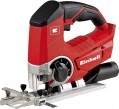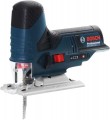Minimum frequency
The minimum stroke frequency of the jigsaw blade during operation. In some cases (for example, when working on metal), a low stroke rate is preferable to a high one; accordingly, the lower the minimum frequency, the more opportunities you will have to set up the instrument for working on a particular material.
Max. frequency
The maximum stroke frequency of the jigsaw blade during operation. The
higher the stroke rate, the higher the performance of the tool and the cleaner and more accurate the cut, usually. On the other hand, high speed is not optimal for all materials; picking up a "high-speed" jigsaw is worth it if it is planned to be used mainly for woodworking.
Also note that the characteristics of the tool usually indicate the maximum frequency at idle; at work, it is usually less. However, this parameter quite allows you to compare different tools with each other.
Stroke
The length of the stroke of the working blade of the jigsaw during operation. The longer the stroke, the more of the file will be in contact with the material in one movement; accordingly, at the same frequency of movement of the blade, a jigsaw with a longer stroke length will be more performant.
Angled shoe
The maximum angle by which the sole of the jigsaw can deviate from the horizontal to the right or left (usually, the possibility of deviation in both directions is provided).
The slope of the sole allows for bevel cuts. Most often, its angle does not exceed 45 °.
Handle
The shape of the jigsaw handle determines the way it is held during operation, as well as some application features. Today the following types of handles are used:
—
D-shaped. Sometimes also called “staple-shaped”. True to its name, it is shaped like the letter “D” rotated 90°. The advantage of such jigsaws is the ability to work with one hand; on the other hand, they are poorly suitable for figured sawing, especially with complex shapes of cuts.
—
Mushroom-shaped(rounded holder). In our catalog, this category includes all jigsaws equipped with an additional protrusion holder in the front part. This protrusion makes it easier to hold the tool with both hands, which is especially important when making cuts of complex shapes. Accordingly, such tools are considered more suitable for figure sawing. Among the disadvantages, visibility during operation is somewhat worse than in the case of a D-shaped handle.
Wood
Maximum cutting depth in wood, in other words — the maximum thickness of a wooden workpiece that a jigsaw can handle. This parameter characterizes not only directly the maximum thickness of the material, but also the performance of the tool as a whole: the greater the depth of cut, the higher the performance. In the case of wood for domestic use, a depth of about 70 mm is considered sufficient, deeper models are usually professional.
It is worth noting that the depth of cut is usually indicated for certain files recommended by the manufacturer for a particular material. The use of other canvases does not guarantee compliance with the claimed parameters, and in some cases it is even fraught with breakdowns and injuries.
Aluminium
The maximum cutting depth when working on aluminium and its alloys, in other words, the maximum thickness of a workpiece made of these materials that a jigsaw can cut through. In general, aluminium and its alloys are softer than steel, and therefore the depth of cut through them is greater - in professional models it can reach 30 mm.
Steel
The maximum depth of cut in steel, in fact, is the maximum thickness of a workpiece made of steel or other metal of similar characteristics that a jigsaw can handle. For more information about the depth of cut, see "Wood", here we note that due to the hardness of the material, even in professional models, this parameter rarely exceeds 10 mm.
Battery platform
The name of the battery platform supported by the device. A single battery platform is used to combine various power tools of the same brand (screwdriver, grinder, circular saw, etc.) into one line. Devices on the same platform use interchangeable batteries and chargers. Thanks to this, for example, there is no need to select a battery for each individual power tool model, because one purchased as a spare battery can be used in various power tools, depending on the situation or as needed. Batteries of the same platform basically differ from each other except perhaps in capacity.

